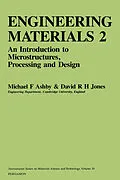Provides a thorough explanation of the basic properties of materials; of how these can be controlled by processing; of how materials are formed, joined and finished; and of the chain of reasoning that leads to a successful choice of material for a particular application. The materials covered are grouped into four classes: metals, ceramics, polymers and composites. Each class is studied in turn, identifying the families of materials in the class, the microstructural features, the processes or treatments used to obtain a particular structure and their design applications. The text is supplemented by practical case studies and example problems with answers, and a valuable programmed learning course on phase diagrams.
Autorentext
Royal Society Research Professor Emeritus at Cambridge University and Former Visiting Professor of Design at the Royal College of Art, London, UK
Mike Ashby is sole or lead author of several of Elsevier's top selling engineering textbooks, including Materials and Design: The Art and Science of Material Selection in Product Design, Materials Selection in Mechanical Design, Materials and the Environment, and Materials: Engineering, Science, Processing and Design. He is also coauthor of the books Engineering Materials 1&2, and Nanomaterials, Nanotechnologies and Design.
Inhalt
Metals. Metals. Metal structures. Equilibrium constitution and phase diagrams. Case studies in phase diagrams. The driving force for structural change. Kinetics of structural change I: Diffusive transformations. Kinetics of structural change II: Nucleation. Kinetics of structural change III: Displacive transformations. Case studies in phase transformations. The light alloys. Steels I. Carbon steels. Steels II. Alloy steels. Case studies in steels. Production, forming and joining of metals. Ceramics and Glasses. Ceramics and glasses. Structure of ceramics. The mechanical properties of ceramics. The statistics of brittle fracture and case study. Production, forming and joining of ceramics. Special topic: cements and concretes. Polymers and Composites. Polymers and composites. The structure of polymers. Mechanical behaviour of polymers. Production, forming and joining of polymers. Composites: fibrous, particulate and foamed. Special topic: wood. Designing with Metals, Ceramics, Polymers and Composites: Design with materials. Case studies in design. Appendices. Teach yourself phase diagrams. Examples, symbols and formulae. Index.
265 illus.
